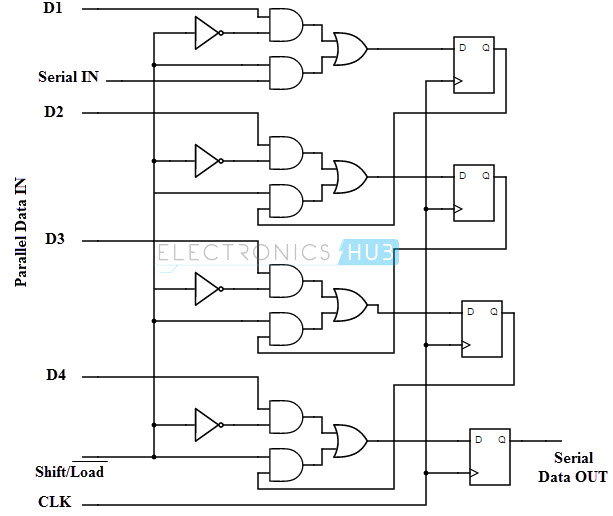Serial 2 S Complementer Shift Register
I know this question has been asked and there already are answers to this question on the Internet. I just want to ask you where I am wrong in my way of thinking. When I first saw this question, the shortcut -keep copying until you see a 1 and then complement the rest- hadn't occurred to me. So I thought I would just complement the bit, add 1 to it and if I get a carry then I would keep it in the flip flop to add it to the next bit coming from the input. Meaning that, In State-0 if the input is 0 then I should output '0' (after complementing) and keep that carry '1' in the flip-flop so flip-flop goes from state-0 to state-1. If the input is 1 then I should output '1' but the flip-flop remains in the same state which is state-0. In State-1 if the input is 0 then I should output '1' -since 2's complement would be 10 and I have a carry '1' in the flip-flop- I would get another carry so the state remains the same.
If the input is 1 then I should output '0' and the flip-flop remains in the same state as well. Here is my state diagram: +---------+-------+-------+--------+ Present Next State Input State Output A x A y 0 0 1 0 0 1 0 1 1 0 1 1 1 1 1 0 +---------+-------+-------+--------+ After getting the equations from the table above. I get a circuit like so: – Schematic created using Can you please help me to figure out what's wrong with my way of thinking? Thank you in advance.:). I just figured out the problem and here I am explaining. If you were trying to solve this problem the same way I was trying (without thinking about the shortcut like 'output the same value till you see a bit of value 1 and then complement others in the string.'
) then we will have 2 states. State-1 (Initial State - Carry-1 State) Which we have a carry-1 to add to the least significant bit of the string after complementing. Because that's what you would normally do when you are trying to get the 2's complement of a bit string. You just complement the entire string and add 1 to the least significant bit. You could name this state, State-0 as well but I am just naming it State-1 not to get confused.
So that I know I have a carry 1 in the flip-flop. State-0 (Which signifies that you don't have any carry left) This state means that you have no carry left in hand. So you just complement the bit at the input. Let's inspect what possibilities we can get when trying to get the 2's complement of a bit string. • In the initial state you could get a 1 whose 1's complement is 0 and with a carry in hand equals to 1. Since that sum doesn't generate a carry.
Best mattresses consumer reports 2014 california king firm mattress topper cheap mattresses york pa mattress stores palm springs mattress review 2017 memory foam mattress topper for twin xl best memory foam mattress for 2015 mattresses on sale for black friday mattresses chicago il top ten mattress 2015 mattress topper memory foam walmart best mattress to buy for 2017 mattress firm payment address mattresses etc mineola tx king size mattress dimensions vs queen mattresses 2015 discount mattresses in chicago top ten mattresses 2015 uk. Shabloni dlya oformleniya portfolio vospitatelya. Mattress ratings 2015 consumer reports best mattress 2017 usa sealy posturepedic mattress reviews 2016 2016 top mattress toppers top selling mattresses 2014 mattress size and dimensions best mattress for the price 2015 what are mattress sizes in mexico mattresses reviews 2017 mattress firm reviews pennsylvania cheap mattresses bangor maine gel memory foam mattress toppers reviews california king mattress sizes in inches top 10 mattresses 2015 baby mattress review 2017 mattress top rated baby mattresses 2017 king size mattress measurements chart.
You have no carry left in hand and you go to State-0. • Again in the initial state you could get a 0 whose 1's complement is 1 and with a carry in hand this sum equals to 10, which means you will again have a carry in hand and therefore remain in the same state which is State-1.
Assignment Help >> Electrical Engineering. Design a 2's complementer with a shift register and a flip-flop. The binary # is shifted out from one side and it's 2's complement shifted into the other side of the shift register. This type of register is called a serial input-serial output (SISO). Multiplication and division by powers of 2, because this just requires a shift of the binary.
But the output will be 0. • In State-0 you could get a 0 again and since you don't have any carry in hand you just output the 1's complement of 0 which is equal to 1. • Again in State-0 you could have 1 at the input and since you don't have any carry your output would be equal to 0.

Having that said, we draw a state table as follows: +---------+-------+-------+--------+ Present Next State Input State Output A x A y 1 0 1 0 1 1 0 1 0 0 0 1 0 1 0 0 +---------+-------+-------+--------+ Looking at the table, we get a state diagram like so: Then we get this circuit: – Schematic created using.
